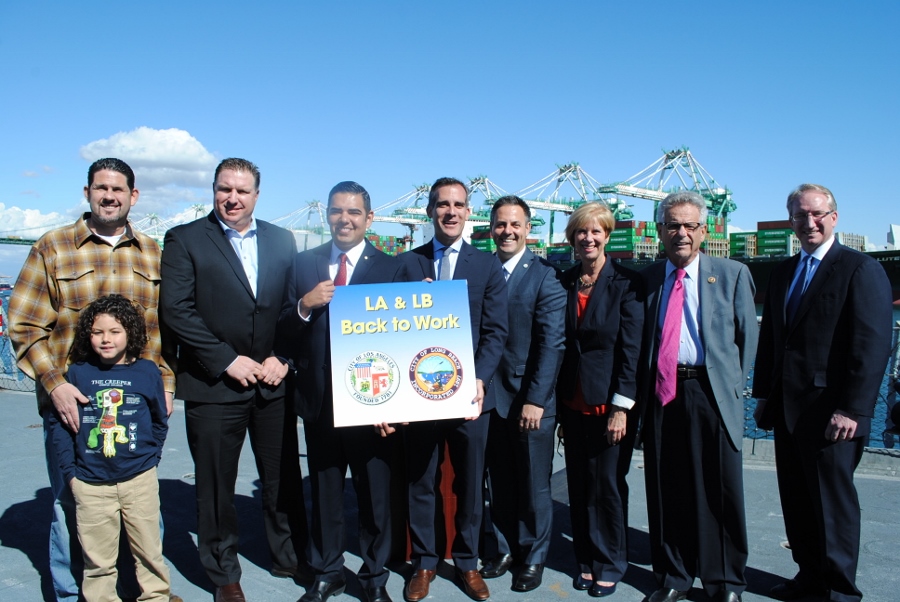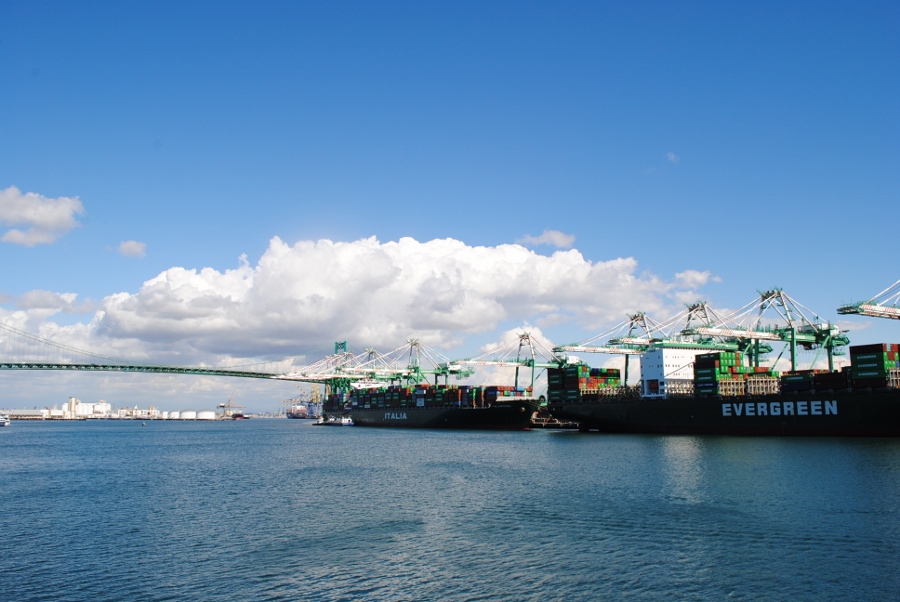
Photos by Asia Morris.
On a bright and windy afternoon, aboard the USS IOWA in San Pedro, Long Beach Mayor Robert Garcia and Los Angeles Mayor Eric Garcetti congratulated the ILWU and the PMA for coming to a tentative contract agreement last Friday. The two mayors spoke Monday to a sea of media personnel, ILWU members, PMA representatives, friends and fellows of the two Ports, all the while standing in front of two gargantuan vessels upon which containers were being loaded and unloaded, a truly beautiful site for the sore and tired eyes of those who haven’t, or haven’t been able to work due to the contentious, nine-month-long contract negotiations between the PMA and ILWU.
“Today we celebrate,” said a beaming Mayor Garcetti. “Today we celebrate that Los Angeles and Long Beach are back to work. We celebrate that these great American ports, that are the engine of a great American economy, at a moment when world trade is growing and when which we should benefit, are finally doing what we do best, moving imports and exports through the most dynamic point on the globe for international trade.”
Garcetti iterated that this agreement was made a top priority, that myriad phone calls, meetings, text messages and late nights working, “maybe with some drinks involved,” he said to a few laughs from attendees, was an effort made by all parties that realize “this was bigger than any one of us.”
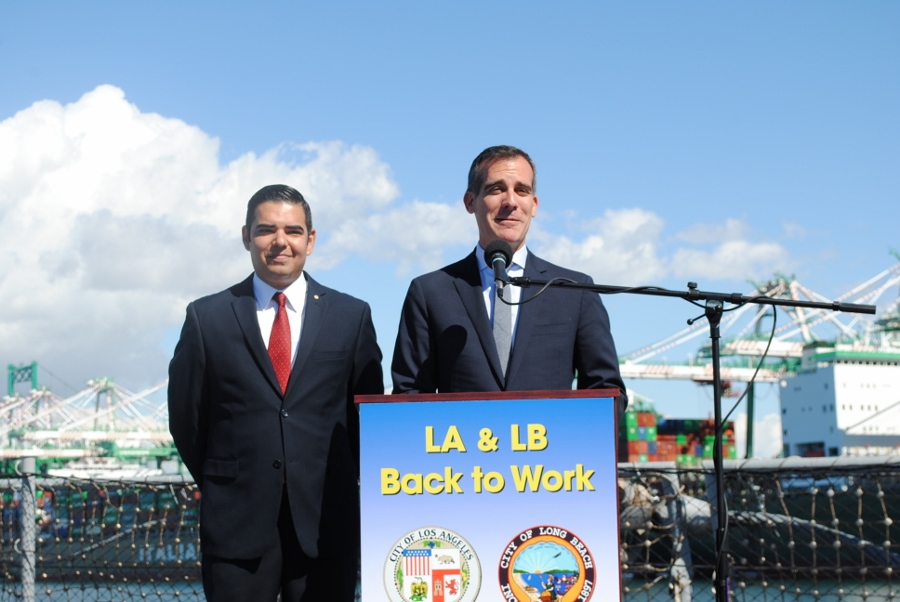 “This was about the economic security of this country,” he continued. “And about making sure that that small shop owner, that she had the goods that she needs to sell on Main St., that the farmers that are in the Central Valley could export those great California goods around the world, that we looked at the jobs that are here on the docks, that are close to the docks, and that are far away from the docks but are dependent on the docks, and made sure that they got moving.”
“This was about the economic security of this country,” he continued. “And about making sure that that small shop owner, that she had the goods that she needs to sell on Main St., that the farmers that are in the Central Valley could export those great California goods around the world, that we looked at the jobs that are here on the docks, that are close to the docks, and that are far away from the docks but are dependent on the docks, and made sure that they got moving.”
He thanked President Obama for sending a relentless closer, Secretary of Labor Thomas Perez, who Garcetti said would send him 5:30AM texts with new ideas and solutions for resolving the negotiations.
Garcetti expounded upon the importance of teamwork, saying “When I was up in San Francisco last week to meet with the parties, I told both sides we needed to end this impasse because the competition we need to worry about isn’t with each other on the docks, the competition is with the rest of the world and we must work together to win.”
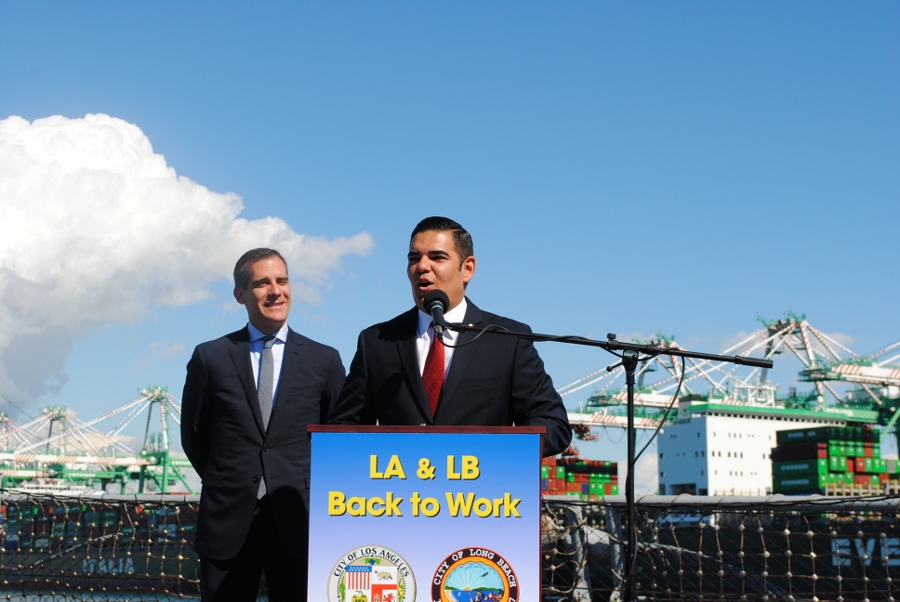 Mayor Garcetti said that the ports of Los Angeles and Long Beach have the same interests, that it’s in everyone’s best interests to work together for the sake of the local, regional and national economy. He succinctly stated that the boundary line that separates the two ports do not, in fact, separate the economy.
Mayor Garcetti said that the ports of Los Angeles and Long Beach have the same interests, that it’s in everyone’s best interests to work together for the sake of the local, regional and national economy. He succinctly stated that the boundary line that separates the two ports do not, in fact, separate the economy.
The two announced a commitment to collaboration, with Garcetti referencing their petition to the Federal Maritime Commission earlier this year for permission to work together on a myriad range of strategic issues, including chassis supply and storage, vessel calls and truck turn times, issues that have contributed greatly to the congestion, alongside the once-stalled negotiations, at the West Coast ports.
Mayor Garcia affirmed Long Beach’s commitment to working with the Port of Los Angeles, saying that the success of each is dependent on the other.
“We share the same air, we share the same infrastructure, we share the same concerns when it comes to the environment, we share a need to ensure that both ports are successful, for Long Beach to succeed, Los Angeles has to succeed, for Los Angeles to succeed, Long Beach has to succeed,” said an emphatic Mayor Garcia. “And so we’re committed, along with our port executive team and our commissions to ensure that we begin this new era of cooperation between the two ports and that we work together in the areas that are appropriate, to ensure that we’re bringing business back to Long Beach and to LA and to increase the supply we already have here in place.”
He continued, “Let there be no mistake that the Ports of Long Beach and Los Angeles are still the best place to do business in the entire country, if not the world.”
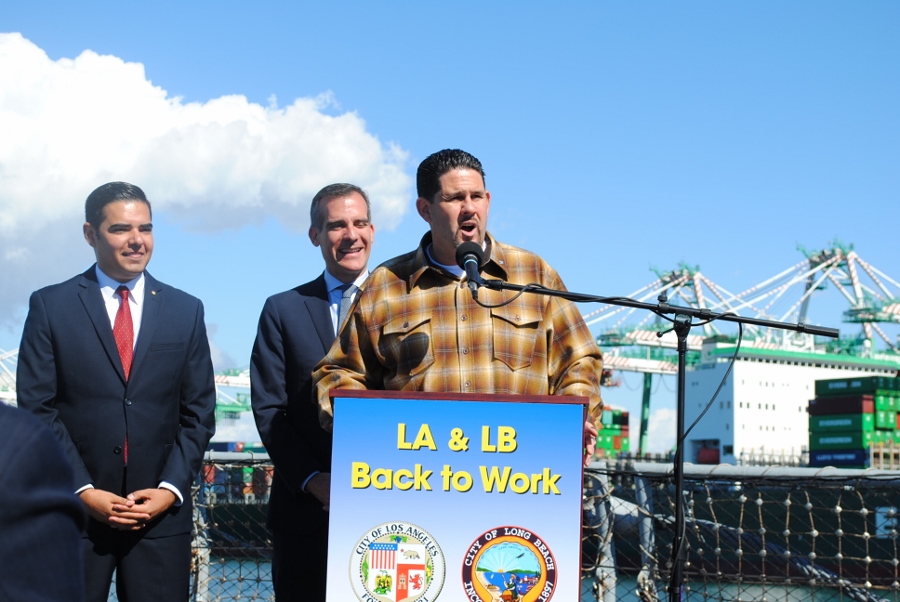 Bobby Olvera, President of ILWU Local 13 explained that, with the contentious rhetoric of the negotiations aside, now is the time for the longshoremen to get back to work, to prove, once again, that Southern California has the best workforce.
Bobby Olvera, President of ILWU Local 13 explained that, with the contentious rhetoric of the negotiations aside, now is the time for the longshoremen to get back to work, to prove, once again, that Southern California has the best workforce.
“When permitted to do our jobs, we move containers, break bulk cargo, autos, cruise ships, chilean fruit, better than anybody in the world, bar none,” he said. “And we’re committed not only now, but long term to make sure these cans move to make sure our communities move and to make sure our economy moves nationally, because the mayor has put it very clearly, these two twin ports move the economy here.”
“With that, I want to give you a commitment from the 7,000 members of Local 13, and if you’re listening to this in Connecticut or back East buried in snow, your goods are on the way,” he continued.
“We’re going to work seven days a week and ’round the clock to get those containers moved, to get the cargo on the shelves and as I told my son Adan this morning, we’re going to make sure the Easter Bunny visits everybody in the United States this year,” Olvera concluded to applause.
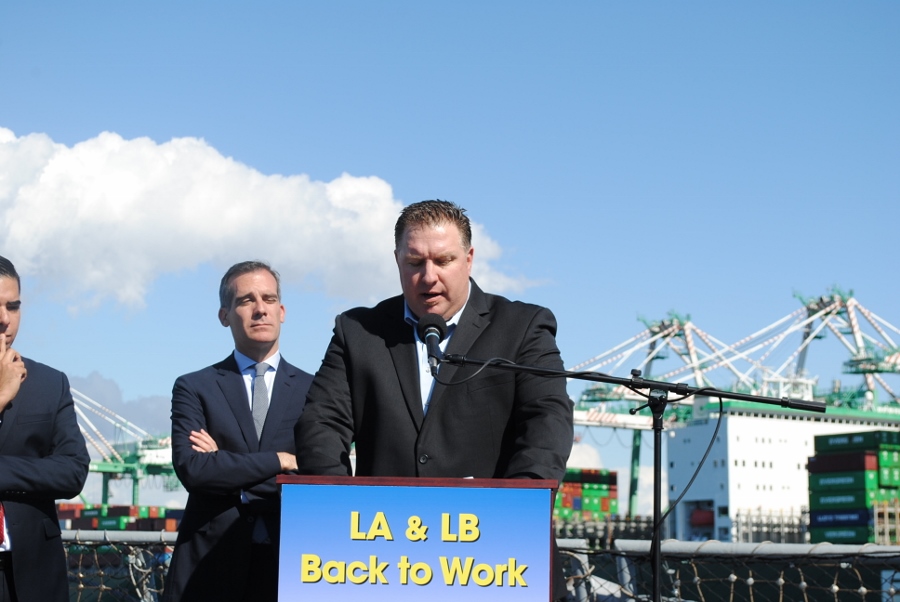 PMA Vice President Chad Lindsay explained succinctly that while the agreement is tentative and must now be passed along to the PMA’s members for review and approval, the deal reached in San Francisco on Friday is an integral step in returning the ports to normal operations.
PMA Vice President Chad Lindsay explained succinctly that while the agreement is tentative and must now be passed along to the PMA’s members for review and approval, the deal reached in San Francisco on Friday is an integral step in returning the ports to normal operations.
“Our focus now,” he said, “is getting cargo moving, working through the backlog and getting containers unloaded and on their way to customers as well as getting exports on the ships and off to international markets. We know there’s a lot of work to do. There have been significant impacts for many and we haven’t lost sight of that.”
Janice Hahn, congresswoman of the 44th district and co-founder and co-chair of the Congressional Ports Caucus, commended both parties for staying at the negotiating table until the tentative agreement was reached. Said she was getting calls from every congress member who represented every state in the country, relaying their worries about getting the ports up and running again.
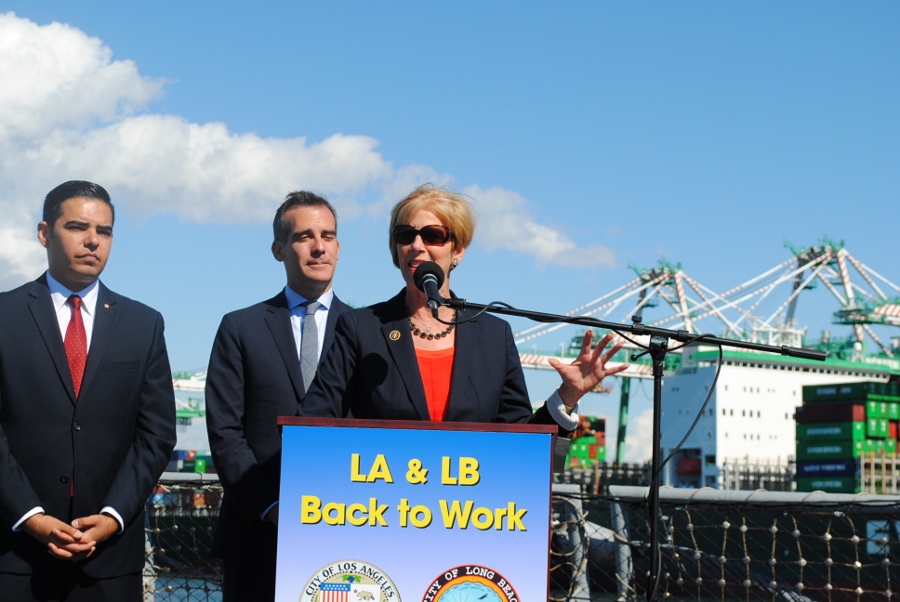 “It was interesting for me as a congress member to realize that—finally—that the rest of the country began to understand the importance, the national significance of the West Coast ports and while it was unfortunate that it took this kind of crisis to bring more awareness to the rest of the country, I think I will get more members who will want to join my Congressional Ports Caucus now,” she said.
“It was interesting for me as a congress member to realize that—finally—that the rest of the country began to understand the importance, the national significance of the West Coast ports and while it was unfortunate that it took this kind of crisis to bring more awareness to the rest of the country, I think I will get more members who will want to join my Congressional Ports Caucus now,” she said.
Hahn said that she will fight to pass a bill to build a national freight network, as well as to keep the money that is collected at the ports within the ports.
“This agreement benefits the workers, this benefits businesses, it benefits consumers across this country and those of us who live and work right here in the port community, everybody we know either works on the docks, is married to somebody who works on the docks, knows a family member who works on the docks, so our economy in our local community’s completely dependent on what goes on on these docks,” she said proudly.
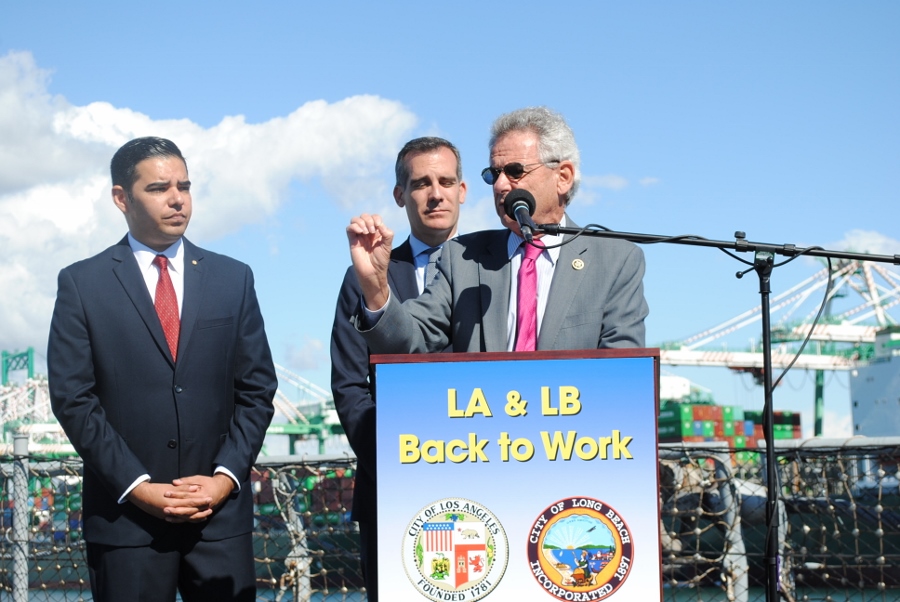 Congressman Alan Lowenthal also commended both parties for reaching an agreement, and cast the situation over the past nine months in a more positive light, saying that it is “exciting to know in times of crisis and struggles that we’ve gone through […], you either come out stronger or weaker, and we are demonstrating that we are stronger. We are using this as an opportunity to rebuild our infrastructure, to rebuild America, to really focus on what’s really important.”
Congressman Alan Lowenthal also commended both parties for reaching an agreement, and cast the situation over the past nine months in a more positive light, saying that it is “exciting to know in times of crisis and struggles that we’ve gone through […], you either come out stronger or weaker, and we are demonstrating that we are stronger. We are using this as an opportunity to rebuild our infrastructure, to rebuild America, to really focus on what’s really important.”
Joe Buscaino, Los Angeles City councilmember of the 15th district, described a story that perhaps hit home for every business owner and person affected by the congestion and now finally, tentatively closed negotiations.
 “Two months ago I got a call from my six-year-old nephew, Lucas,” said Buscaino. “He says ‘Uncle Joe, I have my bedroom set waiting to arrive at the port, what is taking so long?’ Lucas’ mother is a dockworker, his step father is a dockworker. I go, ‘Ask mom and Jerry.’ But Friday night I was pleased to call Lucas and tell him that his bedroom set is coming home. And that’s one of many stories that we’ve heard the last several months.”
“Two months ago I got a call from my six-year-old nephew, Lucas,” said Buscaino. “He says ‘Uncle Joe, I have my bedroom set waiting to arrive at the port, what is taking so long?’ Lucas’ mother is a dockworker, his step father is a dockworker. I go, ‘Ask mom and Jerry.’ But Friday night I was pleased to call Lucas and tell him that his bedroom set is coming home. And that’s one of many stories that we’ve heard the last several months.”
He described standing proudly with his brothers and sisters as they walked along Harbor Blvd. during the ILWU march in January to protest the PMA-initiated vessel unloading night shifts, describing the 6,000 longshore workers, as well as community members who joined the event.
POLA Executive Director, Gene Seroka, introduced by Garcetti as the hardest working official behind the scenes, described the current situation bluntly.
“Today, behind me, we’re working 22 vessels, we have 35 more ships at anchor at our break water and two dozen more on their way pointed to Los Angeles and Long Beach,” he said. “There’s much work to do, but we also have the largest and most skilled labor force in North America, and in the weeks ahead those men and women will be working hard day and night to help us clear the cargo backlog.”
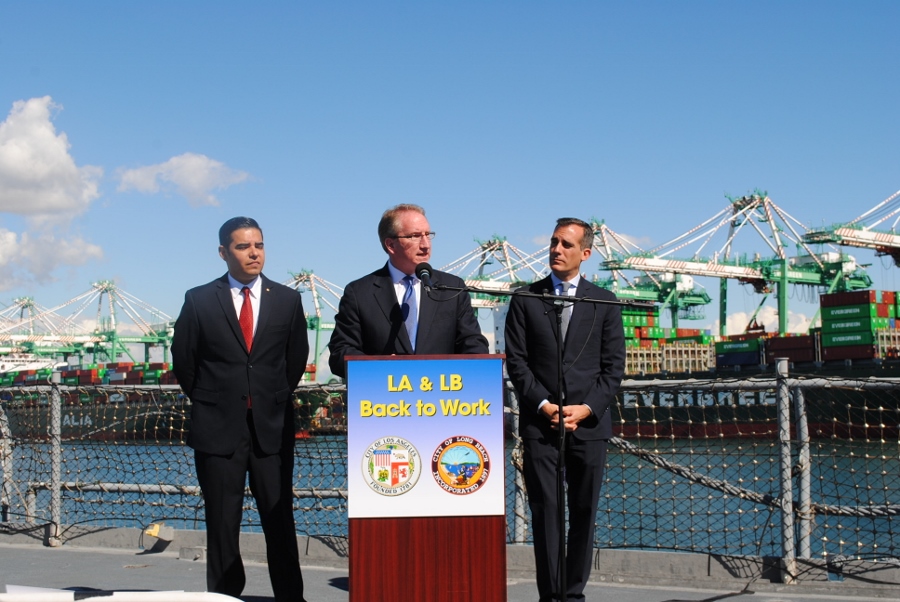 “[I]t may take us approximately three months get back to a sense of normalcy,” he continued, “but all that work begins now and will continue to push forward in assisting the supply chain within the changing industry landscape that we face today.”
“[I]t may take us approximately three months get back to a sense of normalcy,” he continued, “but all that work begins now and will continue to push forward in assisting the supply chain within the changing industry landscape that we face today.”
Seroka said that the tentative agreement, which has yet to be ratified, will create a path for their supply chain partners to address industry changes such as larger vessels, by addressing the details of how the supply chain works.
He continued, “We need to work through all the nodes of the supply chain to develop better communications and IT solutions, more planning and predictability, more scheduling refinements from port of origin to final destination, better container sorting strategies, work with dispatching those trucks in a proper way and finding that new chassis system which will begin on March 1st, to help improve the work that we do around our port complex.”
Garcetti said the twin ports will work to change how negotiations are conducted, so that in five years when the time comes again to hash out a new contract, they can get it finished ahead of time, without the kind of economic damage both the ports and the country have suffered over the past nine months.
Mayor Garcia said the two mayors will work together to figure out what it will take from a funding point of view to “ensure that our roads, our bridges our port infrastructure is the best in the world, to move the cargo quickly, there’s no questions that if you want to get cargo or goods to Chicago or to the midwest even to the east coast, from Asia or the pacific rim, you gotta go in from Long Beach and Los Angeles. It’s the fastest way, it’s the most efficient, it’s the most sustainable, you’ll be doing better for the environment and we’re committed to that growth.”
“We don’t want to say just because we’re faster, to trust us and use us for four years and then for the year when we’re negotiating go someplace else,” said Garcetti. “We want to get this done ahead of time next time we want to make sure we change how we do that and I think that we have parties that have been battered and bruised enough that they’re going to be a part of helping shape that in a way that still retains their needs but that aligns them, so that it’s no longer labor against management but it’s the ports for each other.”
